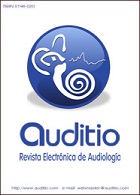Auditory Steady-State Evoked Responses in Newborns: Differences in Bone-Air Conduction at the Frequencies of 500 and 2000 Hz
DOI:
https://doi.org/10.51445/sja.auditio.vol4.2015.0053Keywords:
auditory steady-state responses, air conduction, bone conductionAbstract
Introduction: Auditory Steady State Evoked Responses (ASSR) constitute a valid method for the objective evaluation of hearing. The detection of responses in newborns based on stimulation by air and bone is a subject little published in the literature, constituting an interesting topic for the proposal of this technique as a tool for hearing screening.
Objective: To determine the differences in hearing thresholds with ASSR in newborns at frequencies of 500 and 2000 Hz, presenting stimuli by air and bone.
Material and Method: A group of 15 newborns was evaluated with ASSR until obtaining the electrophysiological threshold at the frequencies of 500 and 2000 Hz, stimulating the airway and bone independently.
Results: A significant difference is obtained in the auditory response thresholds as a function of the stimulation pathway and frequency. In bone conduction, responses were obtained at a lower intensity (24 ± 7) at 500 Hz, compared with the results obtained for the air conduction (46 ± 6) at the same frequency. For 2000 Hz there was an opposite effect with a higher detection for the air conduction, obtaining a mean threshold value (30 ± 8) lower than the result for the bone conduction (41 ± 6).
Conclusions: The results obtained allow us to conclude that the best frequency for the exploration of the airway in newborns is 2000 Hz and for the bone route 500 Hz.
Downloads
Visibility and Altmetrics
Metrics
References
Cone-Wesson, B., Rickards, F., Poulis, C., Parker, J., Tan, L., & Pollard, J. The auditory steady-state response: clinical obser vations and applications in infants and children. J.Am.Acad.Audiol. 2002; (13): 270-282. https://doi.org/10.1055/s-0040-1715970
Dimitrijevic, A., John, M. S., Van Roon, P., Purcell, D. W., Adamonis, J., Ostroff, J. et al. Estimating the audiogram using mul tiple auditory steady-state responses. J.Am.Acad.Audiol. 2002; (13): 205-224. https://doi.org/10.1055/s-0040-1715964
Firszt, J. B., Gaggl, W., Runge-Samuelson, C. L., Burg, L. S., & Wackym, P. A. Auditory sensitivity in children using the audi tory steady-state response. Arch.Otolaryngol.Head Neck Surg. 2004; (130): 536-540. https://doi.org/10.1001/archotol.130.5.536
Herdman, A. T. & Stapells, D. K. Auditory steady-state res ponse thresholds of adults with sensorineural hearing impairments. Int.J.Audiol; 2003. 42, 237-248. https://doi.org/10.3109/14992020309078343
Hernández Cordero, M. C.; Pérez Abalo, M. C.; Rodríguez Dávila, E.; Rioja Rodríguez L. La audiometría por vía ósea mediante potenciales evocados auditivos de estado estable a multifrecuencia: estudio en sujetos normoyentes Rev Logop Foniatr Audiol 2007; (27):86-91. https://doi.org/10.1016/S0214-4603(07)70077-3
Lins, O. G. & Picton, T. W. Auditory steady-state responses to multiple simultaneous stimuli. Electroencephalogr.Clin.Neurophy siol.1995; (96) : 420-432. https://doi.org/10.1016/0168-5597(95)00048-W
Lins, O. G., Picton, T. W., Boucher, B. L., Durieux-Smith, A., Champagne, S. C., Moran, L. M. et al. Frequency-specific au diometry using steady-state responses. Ear Hear; 1996; (17): 81-96. https://doi.org/10.1097/00003446-199604000-00001
Perez-Abalo, M. C., Savio, G., Torres, A., Martin, V., Rodri guez, E., & Galan, L. Steady state responses to multiple amplitude-modulated tones: an optimized method to test frequency-specific thresholds in hearing-impaired children and normal-hearing subjects. Ear Hear. 2001; (22): 200-211. https://doi.org/10.1097/00003446-200106000-00004
Picton, T. W., Dimitrijevic, A., & John, M. S. Multiple auditory steady-state responses. Ann.Otol.Rhinol.Laryngol.Suppl, 2002; 189, 16-21. https://doi.org/10.1177/00034894021110S504
Picton, T. W., John, M. S., Dimitrijevic, A., & Purcell, D. Human auditory steady-state responses. Int.J.Audiol; 2003; (42): 177- 219. https://doi.org/10.3109/14992020309101316
Savio, G., Pérez-Abalo MC, Valdes, J.L., Martín, V., Sierra, C.E., Rodríguez, E. Potenciales Evocados auditivos de estado es table a múltiples frecuencias: Una nueva alternativa para evaluar la audición en forma objetiva. Acta de Otorrinolaringología y Cirugía de Cabeza y Cuello; 1997; (25): 87-97.
Savio, G., Cardenas, J., Perez, A. M., Gonzalez, A., & Val des, J. The low and high frequency auditory steady state responses mature at different rates. Audiol.Neurootol. 2001; (6): 279-287. https://doi.org/10.1159/000046133
Small, S. A. & Stapells, D. R. Multiple auditory steady-state response thresholds to bone-conduction stimuli in young infants with normal hearing. Ear Hear, 2006; (27): 219-228. https://doi.org/10.1097/01.aud.0000215974.74293.b9
Stapells, D. R. & Ruben, R. J. Auditory brain stem responses to bone-conducted tones in infants. Ann.Otol.Rhinol.Laryngol, 1989; (8): 941-949. https://doi.org/10.1177/000348948909801205
Stueve, M. P. & O'Rourke, C. Estimation of hearing loss in children: comparison of auditory steady-state response, auditory bra instem response, and behavioral test methods. Am.J.Audiol. 2003; (12) : 125-136. https://doi.org/10.1044/1059-0889(2003/020)

Downloads
Published
Versions
- 2021-09-13 (2)
- 2015-05-01 (1)
How to Cite
Issue
Section
License
Copyright (c) 2015 Asociación Española de Audiología

This work is licensed under a Creative Commons Attribution 3.0 Unported License.
Articles published after 2020
Authors retain copyright and grant the journal right of first publication with the work simultaneously licensed, unless otherwise indicated, under a Creative Commons Attribution License that allows others to share the work with an acknowledgement of the work's authorship and initial publication in this journal. The authors can choose between the following Creative Commons licenses: https://creativecommons.org/about/cclicenses/
Articles published between 2001 and 2020
The texts published in this journal in the section "AUDITIO 2001-2020" are subject - unless otherwise indicated - to a Creative Commons Attribution 3.0 Spain license. You can copy, distribute, communicate them publicly, make derivative works and commercial uses provided that you acknowledge the credits of the works (authorship, name of the journal, publishing institution) in the manner specified by the authors or by the journal. The full license can be consulted at http://creativecommons.org/licenses/by/3.0/es/deed.es.









